BALLS 2002 - Black Rock, Nevada
Back
BALLS is Tripoli's largest experimental launch.
Its a yearly event that takes place on the
Black Rock playa.
This report covers mainly my own projects.
Myself and my 2 brothers Brad and Jared got a late start heading to Nevada on Friday morning.
We didnt get rolling from my place until about 11:30am.
After a few food and gas stops we didnt make it onto the playa until about 12:30 am saturday morning.
Alex McLaughlin flew into Reno from Portland after work and arrived about 30 minutes later.
We quickly set up camp and crashed for the night.
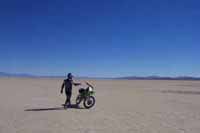 |
My brother Jared and his RRV
(Rocket Recovery Vehicle) on the playa. |
Sunrise hit the Playa and it was the start of a beautiful day.
Blue sky, low winds, perfect flying weather.
I quickly set about sorting through the boxes of tools and rocket bits to get our combined project moving.
We were planning on flying a cluster of 7 38mm motors in Alex's Ultimate Max, a LOC/Precision rocket that was set up to accept 7 38mm motors.
These were not ordinary 38mm motors, though.
The largest commonly available commercial 38mm motor is the Aerotech J570 which contains 16" of propellant.
The motors we had for this flight contained 24" of propellant, with a total length of 27".
One of these motors by themselves is very aggresive, 7 of them at once is just plain nuts.
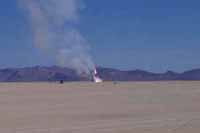 |
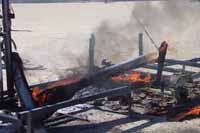 |
| The Tripoli Vegas Q motor cato |
Not much left... |
As things were coming together for the cluster launch the Tripoli Vegas crew had their Q motor ready to go.
There was the countdown and then a BANG.
The forward closure on the motor failed, and blew the top half of the rocket off, which came down under 'chute nearby.
The motor then began burning, and shot a couple fuel grains into the air like a roman candle!
The rocket continued to burn, the motor casing eventually melted and folded over.
It was the most spectacular cato I have ever seen, and very sad indeed.
It would have been great to see it fly rather than burn.
About that time Kent Newman, a friend and fellow Northwest flier, got some bad news about a family member and had to head out.
He flew the rocket he had been prepping that morning on an EX M motor for a perfect flight, coming down under drogue and deploying its main chute right in front of the flight line.
He really showed us how its done.
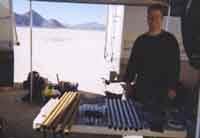 |
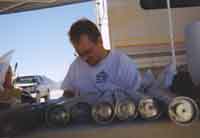 |
All the makings for a
7 motor cluster, just waiting... |
Prepping the motors for the cluster. |
Back to the cluster project.
After spending about an hour cutting and coring grains, then assembling the motors as Alex prepped the rocket, we were ready to launch.
We decided to test the launch system before heading out to be sure we'd get all motors lit.
We pulled out the Magneblaster and set it up with seven Magnelite ignitors.
These are nichrome wire dipped igniters, the hottest stuff you can get.
I then realized I had left the launch control box at home!
No worries, after a few moments I figured out I could short the leads on the wire, basically hotwiring the system.
A test with 7 igniters was successful, and we headed out to the range.
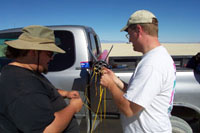 |
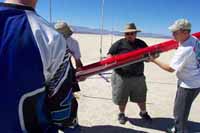 |
Alex McLaughlin and myself
wire the igniters on the 7 motor cluster. |
Loading the rocket on the rail. |
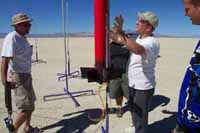 |
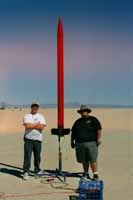 |
Myself telling everyone how my motors
are all going to cato
and smear the rocket all over the playa
(I'm so confident). |
Alex McLaughlin and Myself
with the rocket ready to go |
Once on the range we wired up the rocket with the igniters and got it on the rail.
The launch system was set up, we all pulled back, and it was time to launch.
We called launch control, gave the countdown, and shorted the wires.
WHAAAAAAAAAAM!
The 5.5" diameter 8' long rocket FLEW off the pad over an 8' long flame.
Then things got really scary.
A split second after launch 2 motors skywrited themselves towards the flight line.
One landed in front of the flight line, the other behind.
Thank heavens they didnt hit anyone or anything.
I was so concerned with the wayward motors that I didnt see the rocket again until it was coming down under its main chute.
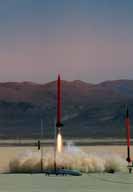 |
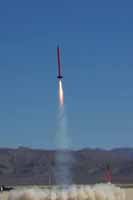 |
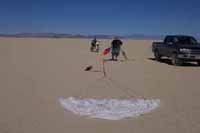 |
| The Ultimate Max lifts off. |
A little higher.
Note the motor falling below the flame... |
A perfect recovery! |
Post mortem examination revealed our motor retention did not take into consideration the negative G's some of the motors experienced.
Some motors came up to pressure a few milliseconds before others, and the slower ones were pulled out by the G forces before coming up to pressure, then flew off on their own.
One motor blew a nozzle and imbedded itself up inside the rocket, but the damage should be repairable.
All in all a rather successful launch!
All seven motors were lit, the rocket flew and was recovered as designed.
We're already talking about doing it again with better motor retention and hotter propellant!
Once we had calmed down from the cluster launch it was time to prep my minimum diameter 75mm M project, Stratosphreak I.
This was a 3" G-10 fiberglass airframe with fiberglass fins surface mounted, then laminated with 2 layers of carbon fiber, vacuum bagged.
The motor was a 7600 NS M.
The goal of this project was to determine if the fin attachment/construction method would hold up to an extreme flight, and to just fly darn high!
Simulations put the 3" bird around 20,000 feet AGL.
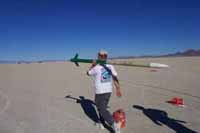 |
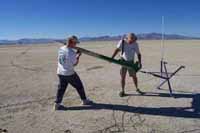 |
Heading out to the pads
with Stratosphreak I. |
Andy Casillas helping
to load the rocket on the rail. |
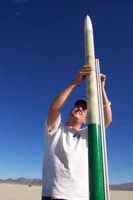 |
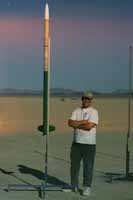 |
| Arming the electronics. |
Ready to go. |
We got the rocket prepped, on the pad, and ready to launch.
After the countdown, things didnt go real well. The motor overpressurized on the pad and blew the nozzle.
All the propellant exited through the back end, and the rocket shot up a couple hundred feet.
The short acceleration period wasnt enough to arm the G-Whiz accelerometer, so no chutes deployed, and it fell back to earth.
The impact cracked 2 of the 3 fins, but they did stay attached!
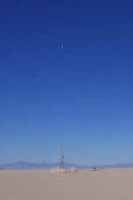 |
The 7600 NS load dumps
out the nozzle end and the rocket
hits a couple hundred feet. |
Post mortem examination of the motor and ejected propellant showed the smoke grain had burned on both ends, causing the overpressure.
I had not inhibited the front end of the smoke grain! DUH!
I then realized I had done the same thing on the N motor I planned to fly the next day, so I broke down that motor and applied a generous layer of RTV silicone to the front of the smoke grain.
One cato per launch is enough for me, thanks.
After that launch we called it a day and relaxed.
We enjoyed a nice campfire that evening, lit by the leftover grains from the 3" cato.
The full moon rose around 8pm, a spectacular site.
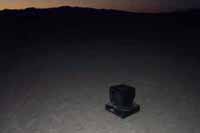 |
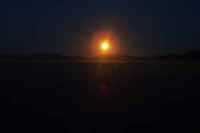 |
Driving across the playa
that evening, my brothers discovered
a computer sitting on the playa.
Apparently an art project left behind
by some Burning Man boners.
We disposed of it at the transfer station
on the way out. |
Full moon rising
over the playa saturday night. |
The next day I prepped my final flight, an N motor in a minumum diameter rocket, very similiar to the 3" rocket.
Again, the goal was to verify the vacuum bagged fin can would hold up to an extreme flight, and just fly high.
In addition, this was the first 98mm motor I had ever cast. An N! I was feeling a little ambitious.
I was also planning on flying a video transmitter put together by Tom Gonser.
He was to fly it first that morning in his rocket, then move it to mine for my flight.
Tom's flight had some recovery issues.
The boost on the John Lyngdal N motor was picture perfect, and the video feed was great.
However, at apogee you can hear the drouge deployment charges firing on the video, but nothing deployed.
The rocket came in hot, deploying and stripping the main chute just before augering into the playa.
The damage was extreme.
The 48" long 98mm motor case was destroyed, and the video payload was reduced to a chunk of plastic.
Very sad indeed.
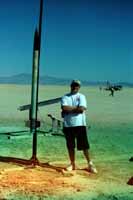 |
Ready to go.
My first 98mm ever.
Not tested.
Maybe I'm standing to close... |
After Tom's flight it was my turn.
We drove out to the away pads and set up Stratosphreak II, my first N motor flight.
Biggest motor I've ever made, biggest motor I'd ever flown, and I only spent about 3 hours building the rocket!
We got it on the pad, armed the altacc, and headed back to the flight line.
Ron Zeppin gave the countdown and hit the button.
The motor flew great.
A perfect boost, accelerated quickly to mach, then a little sidestep.
The rocket seemed to jump sideways, then kept going.
Some pieces fell to the ground and it was quickly determined the nose cone had come off during the flight!
The rocket arced over, then started tumbling.
The rocket is designed to separate at apogee with no drouge, then deploy main at 1000 feet, and I hoped thats what was happening.
However, it tumbled all the way in, and hit the ground.
Turns out when the nose cone came off it took the altimeter battery with it.
The rocket bent a fin (but it was still attached) and the nozzle was shattered by the impact.
However, the motor case survived the impact, and the altacc still powers up and checks out ok.
According to the adopted standards of BALLS 2002, it was a successfull flight since a shovel was not required for recovery!
As we were packing up and preparing to leave, the Gates Brothers flew their large project.
It lifted off on an Animal Motor Works P, then airstarted 3 pairs of N motors!
Truly spectacular.
Another great time on the playa. Cant wait to go back!
Thanks to Brad Deputy, Andy Casillas and Alex McLaughlin for the pictures!
Back

Rocketry | Experimental | Webhosting | Email | Links | Home
Copyright 1998-2014 Greg Deputy - All Rights Reserved
|